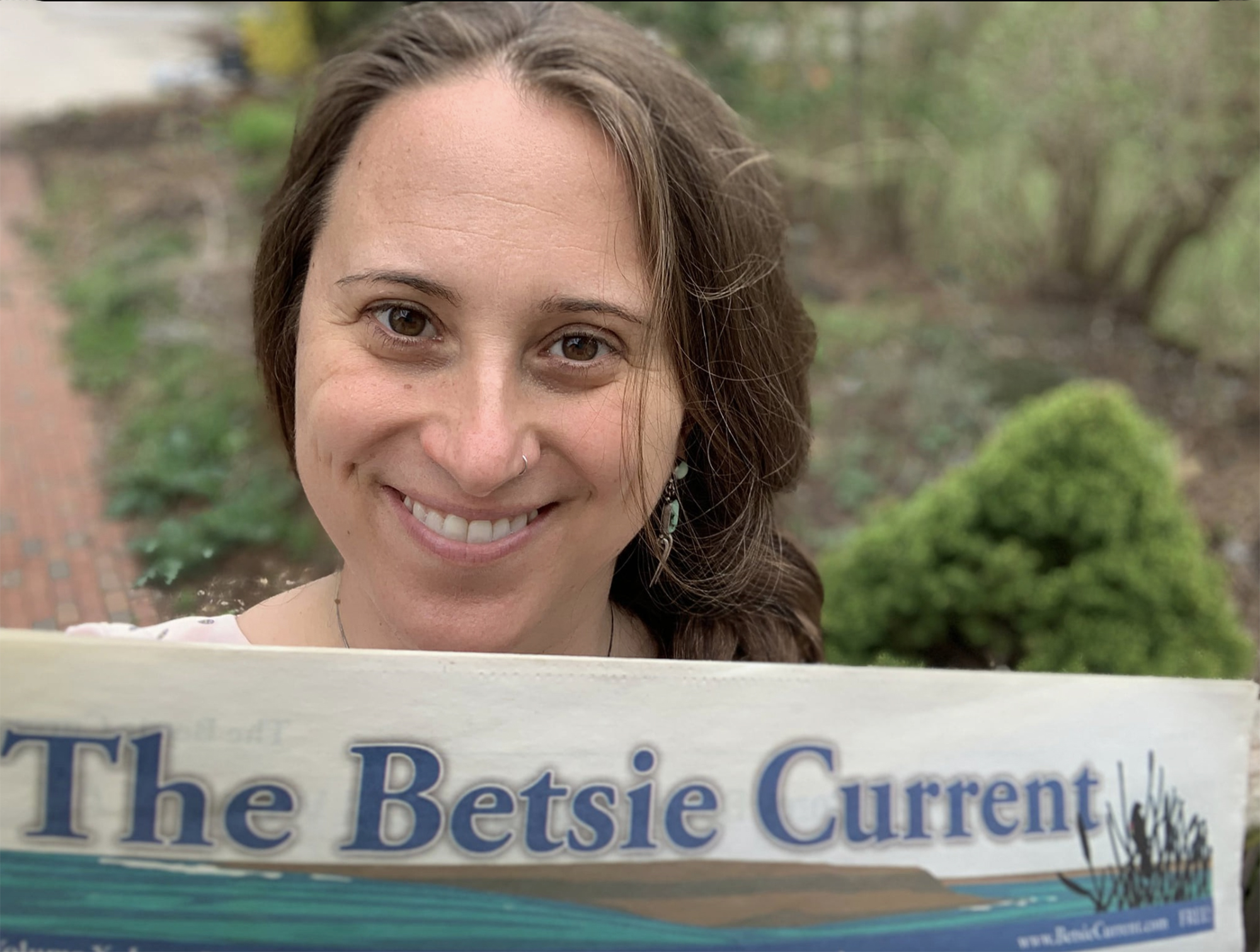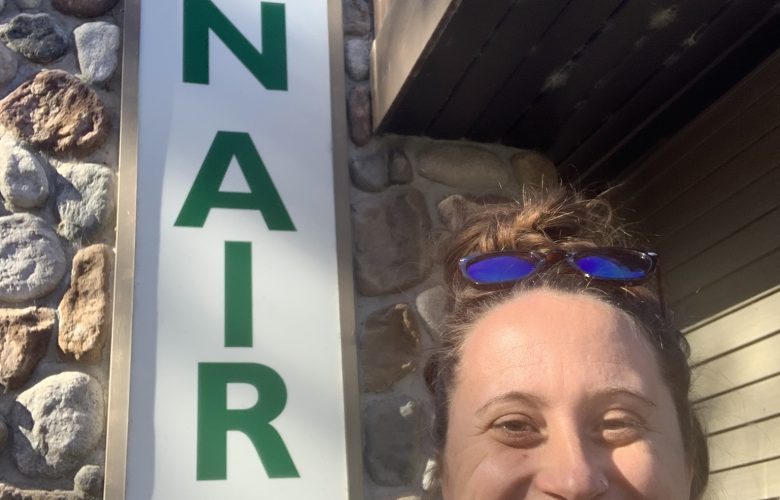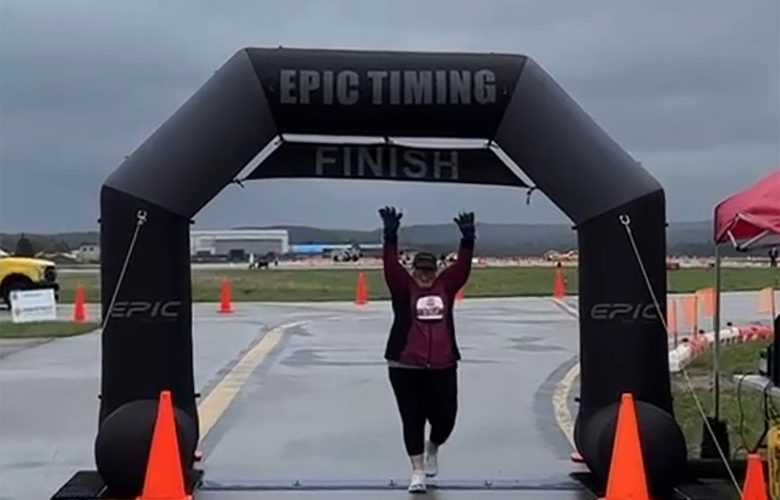Tap into your inner George Bailey
By Aubrey Ann Parker
Current Editor
For those of you who are frequent readers, it probably comes as no surprise that I co-own this small newspaper with Jordan Bates, my partner in love, life, business-, house- and dog-ownership.
Yet, I feel the need to say this, because I am often taken aback by the number of people who think that I *work for* The Betsie Current… I mean, yes, I do work for it—I’m more or less the only full-time employee that works for it, actually, and I wear a lot of different hats.
Co-owner. Editor. Writer (when I have time). Photographer. Ad sales. Delivery. Bookkeeping. Billing. Social media. Events coordinator.
I’ve realized recently that maybe I don’t do the best job of talking about this—especially if people don’t realize that Jordan and I own the paper—so this is my attempt at rectifying that…
Have you ever wondered what owning a newspaper is like? Well, buckle in, folks, because this is a doozy of an editorial
So, if you’re familiar with the Current, you know that we publish 16 issues in a year: once a month from January through May, then every other week from Memorial Day through Labor Day (8 summer issues at that fast clip), then back to once a month from September through December. (Note: Up until 2020, we used to do only 12 issues in a year; basically we took January through April off.)
The reason for less issues in the fall, winter, and spring when compared to summer is pretty simple: it comes down to the dolla’ dolla’ bills, y’all.
Or to be specific, to ad revenue.
You see, our paper is free to the public.
If you follow me and my antics at all—politics, volunteering, coaching, serving on boards, creating/promoting events, rescuing street dogs, etc.—this should come as no surprise: in my heart of hearts, I’m a community organizer. And what is more “community” than a free local paper?!
We want our stories and calendar of events to be accessible to everyone: that’s also why we deliver to so many places.
It would take me a fraction of the time to deliver (which is about 10 hours) if I only put papers out at the big hubs—400 copies at the grocery stores and gas stations, only doing the “big” towns and not the small ones, etc. Places with a lot of foot traffic. But I really and truly try to deliver to just about any business that is open to the public, even if that means I’m only delivering five copies for the people who work in that office, because nobody else really goes in there. This means that I’m delivering to anywhere from 150-250 businesses, depending on the season; some places aren’t open in the winter, for instance.
I recently saw a piece by Mark Kwiatkowski on LinkedIn saying that many small business owners have what he calls “George Bailey Syndrome,” and if you’ve ever seen It’s A Wonderful Life (1946, starring Jimmy Stewart—notably one of my favorite movies of all time), you’ll understand the reference:
“George Bailey Syndrome is when a business owner has worked very hard and helped to make others around them successful, while struggling to get by financially themselves.”
Ugh, that hit home when I read it, ha. (Thanks so much to my mother for making me watch that movie every year at Christmas, sometimes multiple viewings in a year; apparently something stuck!)
And I get the same question all the time: how do you make any money off of a free newspaper?
Well, the truth is that we don’t make a ton—I like to say that we’re not quite “nonprofit journalism,” but we’re more like “very-little-profit.”
But it’s fairly consistent, and I’m grateful for that. (Although, at the beginning of each year, I always panic and worry that this will be the year that we fail; thank you, Anxiety and Rejection Sensitivity Dysphoria!)
The basic take-away is this: we’ve had 319 businesses, organizations, and individuals advertise with us over the past 12 years, which is pretty astounding. Around 50 of those are no longer in business anymore. The past few years, we’ve had around 100 advertisers annually, with around 75 percent returning from the year before. (I don’t know for sure, but I feel like that is a pretty high retention rate for the industry; I’ve tried looking for these metrics before, but haven’t had much luck… so if you know this factoid, please email me!) Additionally, depending on the year, we get around 10 to 25 of the (319 – 50 – 75 = ) 194 who have previously advertised with us to come back again; and depending on the year, we attract 10 to 25 new advertisers. Slight changes each year, but pretty good overall.
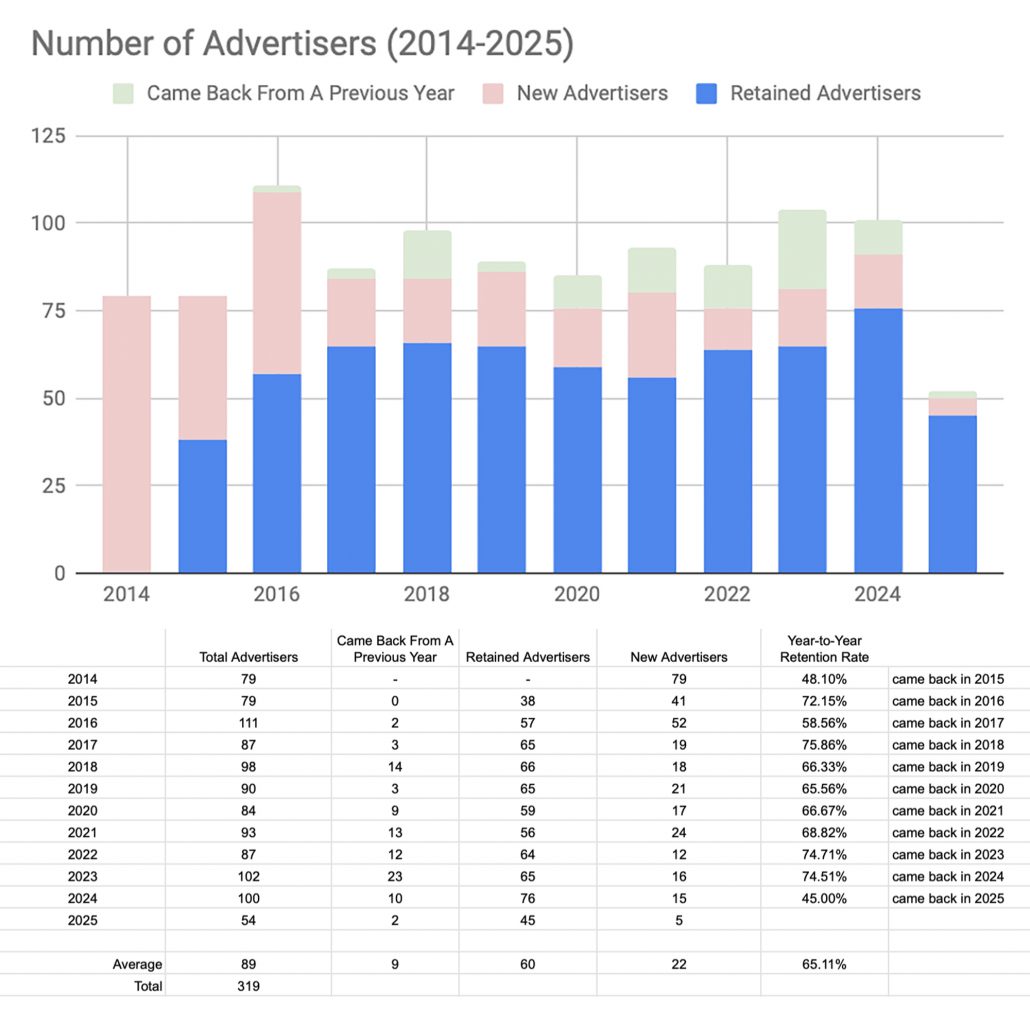
Okay, so, this is how the newspaper is funded, for those of you who have been wondering, “How the heck do they make a living?!”
And because we live in a seasonal/largely tourism economy here in Northern Michigan, it’s no surprise that we would have more advertisers during the summer months (60-90 per issue) compared with the other months of the year (30-40).
That’s why we used to not even bother in January-April (we would have actually lost money to get it printed) and why, even now, we only publish once a month during those “off-season” months, compared to every other week during the height of summer.
But we finally got to a place, just before the COVID-19 pandemic hit (hahaha “God laughs when you make plans,” right?!), where I felt we could *at least* break even on those January-April issues… and more to the point—the George Bailey Syndrome point, that is—I felt like it was important for our community that we be publishing on a more year-round schedule. So we took that leap, and it’s worked out okay so far. (Phew!)
I wanted to put all of this out there, because I get asked quite a bit: “Oh, we haven’t seen a new issue in such a long time! Have you been missing us on your delivery route?” And I have to respond, “Well, we don’t publish as frequently in the winter…” (Notable: If we were to see a big increase in off-season advertisers, we could potentially start publishing every other week for longer into the fall and/or spring season and do more like 20 or 24 issues in a year… more on that below.)
This is also why our off-season issues tend to be smaller (8 pages) compared to our summer issues (12 to 20 pages).
In a nutshell: the sweet spot is to have about 35 percent of the square footage of the newspaper taken up by advertisements. Any less means that we’re paying too much in printing, and any more means that the paper is chock-full of ads and it looks horrendous to read. (At least, we feel that way; maybe you’ve never even noticed? Or maybe you do notice, and you’re like, “Wow, this terrible rag is all ads! Junk, junk, I say!”)
We try to keep it around 35 percent, but that said, sometimes we get a really big ad at the last minute, and there’s just nothing to be done, because I don’t have enough other content (stories) to fill.
So, hang on, I realize that I should probably slow down and explain this a little better: let’s say that I have ads for 35 percent of an 8-pager. Great. And then a big ad comes in, and now I’m at 50 percent of the 8-pager being ads. Well, then I would want to go up to the next size: but I can’t go up by 2 pages; I have to go up in increments of 4 pages. (Because it’s one sheet of paper that is folded in half, front and back; is that confusing or do you understand what I’m saying? Can you visualize it? I hope so…)
So now, I have to go up to 12 pages—and 50 percent of an 8-pager is the same as 35 percent of a 12-pager. That’s why our newspaper will always be 4, 8, 12, 16, or 20 pages. And it’s about finding that sweet spot; do we have too many ads and need to bump up, do we have enough content to fill if we do bump up?
What’s nice is that it used to fluctuate quite a bit issue to issue, but we’ve mostly stabilized in recent years: it’s generally 12 pages from May-December and 8 pages from January-April, with an occasional bigger issue at 16 pages for 4th of July or sometimes in the fall. (We’ve only ever done one 20-pager, and it was during the 2020 election, when we had five full-page ads from various local political groups, on top of the normal advertisements from small businesses, etc.)
As far as non-advertiser content goes (the remaining 65 percent or so of the square footage), there will always be a 2-page calendar of local events—despite Jordan trying to get rid of that duty, ha.
He does the newspaper layout/design and ad creation, and he’s also responsible for filling the calendar—but it’s kind of a mundane and thankless job to log onto the Chamber website and the individual Facebook pages of local businesses to copy/paste/edit each individual event, so he doesn’t like to do it and is always asking if we can hire someone else to do it, or he’ll even throw up his hands and say something like, “Nobody even looks at this anyway!” (Think exasperated little boy crossing his arms and exclaiming, “Harumph!”) To which I just laugh in his face—I know, so supportive—because that is absolutely not true; I have had some people tell me that the calendar is the main reason they pick up the newspaper.
In addition to the 2-page calendar, I always try to have a 2-page Q&A with a local mover/shaker: generally I try to have these be younger people (50 and under), but not always. The point of that series is to try to show that (young, non-retired) people can make a living here: it might just look different than their peers living in big cities—you might have to have multiple part-time jobs or own your own business, etc.
You know what I’m talking about: “View of the bay for half the pay” sorta vibe. But across the board, because I generally ask the same questions each time, almost everyone always mentions how it is a blessing to live here and that it was an intentional decision to be here—whether they moved here from another place, grew up here and moved away but came back, or if they’ve lived here their entire lives and never left. The Q&A is one of my favorite things that we do.
Okay, so beyond that, it depends on how much space is left to fill: if it’s an 8-pager, it likely means only two more stories will fit. Sometimes maybe three. If it’s a 12-pager, I can generally fit three to four stories. If it’s a 16-pager, maybe it’s four to five stories total.
Now, part of that is because we generally run pretty long stories.
When Jacob Wheeler and Jordan (re)started the Current back in 2014, I was technically not as involved as I am now. My thinking was: “I’m going to let the boys do their thing…” And I was employed full time elsewhere, so that was fine.
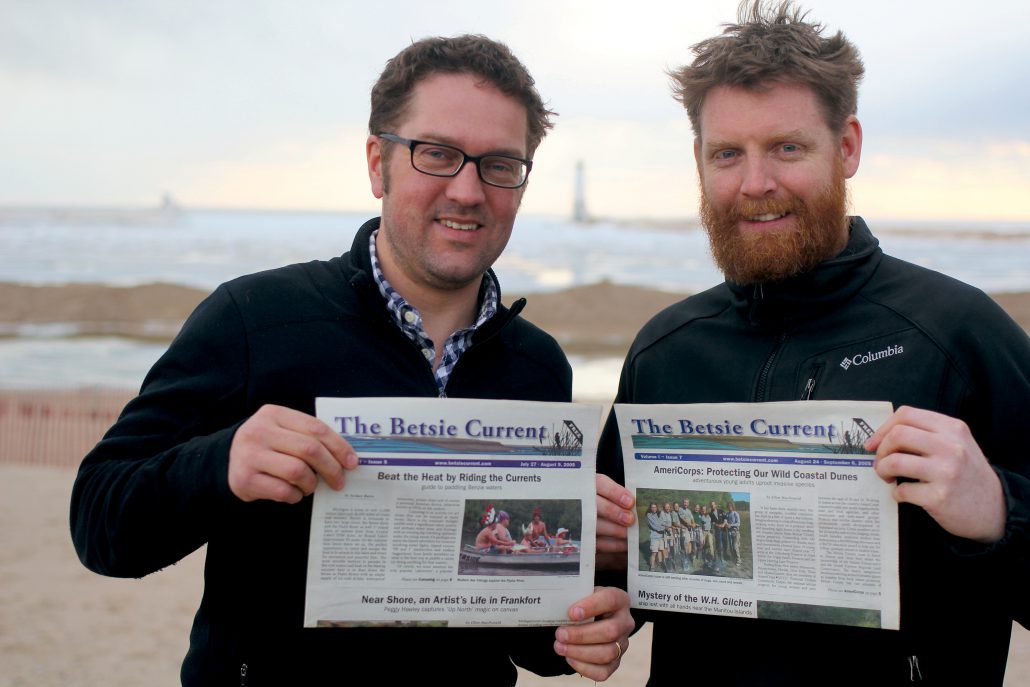
Jacob did the editing and ad sales back then; I helped with deliveries, and I would occasionally write or take photos. But in 2017, Jacob had found a full-time job of his own, and I no longer had mine, and so he backed away from the Current. (He still publishes our Leelanau-based, semi-sister publication, the Glen Arbor Sun, which turns 30 this year… wow, what an accomplishment! And yes, that means he started the paper when he was a pimply-faced teenager! We collaborate with the GAS a lot, often cross-publishing their stories or them cross-publishing ours. And our ad sizes are the same, so we encourage folks to advertise in both papers, if they can.)
So with “Jaxit” (haha get it? Like Brexit, “Britain-Exit,” but Jacob-exit!), I became the editor, and I got to make the decisions. And the decision I made was that I wanted us to write more long-form stories and stop doing shorter stuff and not to run any press releases at all. Ever. i.e. It was going to be all content by our writers (or GAS writers), not by executive directors of local nonprofits trying to get free press for their events–not that that stuff isn’t important, it totally is, but that can go in the Benzie County Record Patriot or the Traverse City Record-Eagle or other local publications that have more pages of content and publish more frequently than we do. (And/or a shortened version could go in our 2-page free community calendar. That’s fine.) But it wasn’t going to be in our story pages, which were limited and which I wanted to feel special…
I wanted original content, and I wanted it to be long-form. I wanted it to be something that you could sink your teeth into; something that you intentionally sat down with a cup of coffee and said, “Hey, I’m going to dedicate some time and space in my day to reading this.”
In large part because that’s the kind of thing that I like to read.
And the older I get—as I inch ever closer to 40 later this year—the more that those memes ring true that say things like: “Be you. Be authentic. Find your niche. Do what makes you special. And the right people will show up.”
To be fair, at first, I had some writers push back; they didn’t want 1,000 words of context added to their pieces. And I had a few readers tell me that our stories had gotten too long. But those were few and far between, actually.
What I found more commonly was people praising us for “upping the game” and comparing us to The New Yorker or Harper’s Magazine. (Which, although I love hearing that, I don’t feel like we’re anywhere closee to that caliber, but I still love the sentiment, and I think it’s something to aspire to, and I appreciate that people see that this is the direction we were looking to go… and notably, we do have writers who have been published in The New York Times or who have worked for Harper’s, so maybe I shouldn’t poo-poo that sentiment too much. Maybe we are “on our way.” It’s easy for me to allow negative thoughts to creep in, and I need to do a better job of looking up instead, which is in large part what the catharsis of this super long essay is doing for me—getting really clear on what we do, why we do it, and the best way for me to get clear on that myself is to explain it to all of you… so thanks again for hanging in here with me.)
These days, we hardly ever run anything that is less than 1,000 words, and most stories average about 2,500 words, with some approaching 4,000 occasionally.
Mostly, the stories are about local businesses or events or people doing cool things; they are generally uplifting/feel-good stories. If we do cover something considered “controversial,” we try to make sure that it’s thoroughly researched with lots of data and/or quotes from experts, and that there is a local angle to it.
The stories are 90 percent specific to Benzie County (or surrounding communities like Empire, Interlochen, Arcadia), but sometimes there are essays we run that are about a more general idea, like about the changing seasons or nature or what have you.
For the past four years, we have also spent one whole issue (September, Suicide Awareness Month) dedicated to first-person narratives of “taboo” subjects that aren’t typically found in a newspaper: mental health challenges, PTSD, sobriety, suicide, miscarriage, ADHD, OCD, transracial adoption, and more. We’ve gotten really great feedback on those issues, and I think it’s really something special.
Readers also love our historical pieces, and I tr* to have one per issue, though I haven’t quite hit that target yet, but it’s pretty close; stories about ghost towns or the maritime industry, etc. Or that explosive “baby farm” story from this past summer. Those historical pieces always get a lot of reactions, with people saying: “I’ve lived here my whole life, and I had no idea!”
Last thing to know about the inner machinations of the newspaper industry is distribution: obviously there are more people here in the summer, so we get more printed then. It’s around 6,500 copies per issue every other week, on average (though 4th of July is bigger, because we also hand them out in the parades, as you may have seen), and the “off season” is closer to 4,500 copies once a month. All in all, lately we’ve been putting out around 180 pages of content and delivering around 75,000 copies per year. Pretty cool.
Okay, so now that you understand a bit about the background of why we publish at the frequency we do, and why certain issues are bigger/smaller than others, and what the content is that we publish, I want to switch gears a bit and go back to the George Bailey of it all…
Sure, I could wax poetic about the dedication that it takes to own a small business, but it’s actually about way more than that…
If there is one take-away that I can leave you with, it’s this idea of the community newspaper—about what it means and what it brings, and why it is that YOU are the important support system that holds the whole thing up.
So, sometimes when I’m pitching to a potential advertiser, they’ll respond that they “don’t need” to advertise or that they want some hard metrics about the “rate of return” before they do.
And most of the time, not gonna lie, I can’t give them that.
Sure, I can give them the facts and figures that I’ve said above in this diatribe about distribution, etc. But so much of advertising is an unknown, depending on your industry.
For instance, a lot of the general contractor-y people have told us that they know they are getting new clients directly from our ads, because people will say, “I saw your ad in the paper, and I called.” Cool. Direct line from A to B. These have been folks like painters, pest control, tree services, lawn maintenance, etc. These kinds of advertisers have all told us, “I know that little ad is working.” (And more often than not, they are choosing the smallest ad size we have: about a business card size. But they’ll be in every single issue, consistently, at that small size.) Also when advertisers have put “hiring” ads in.
So now let’s look at the perspective of the brick-and-mortar businesses—the shops and restaurants, etc. It’s so hard to know if the ads are working directly; there is no line from A to B, necessarily.
However, what I can tell you, anecdotally, is that whenever Jordan is putting the design together for a new issue, and he sees the ad for L’Chayim Delicatessen or whatever, he’ll be like, “Hey, I’m hungry. I don’t have time to make lunch today, because we gotta get this to the printers, and we haven’t been to L’chayim in a while, and that’s what I want for lunch. I’m going to go pick up a sandwich!” But does Jordan then say to Jonathan Clark, “Hey, I saw the ad today in the paper, and that’s why I’m here!” No. He doesn’t do that. That would be a little weird. But was he influenced by the ad? Sure, yes, of course.
So I’m sure that, if that kind of thing happens when Jordan is putting together the paper digitally, it must happen when our readers pick up a hard copy, too. But is it hard to prove? Hell yes.
Okay, let’s back up a bit, though. Because again, this seems very microscopic and kinda capitalist and not very all-encompassing, George Bailey, community, touchy-feely…
Back in October, our Q&A featured Melissa (Basileo) Forster (37), the owner of Farm to Needle Yarn Shop, a new store in Beulah. Maybe you read it. If you didn’t: she grew up here, moved away, worked in corporate jobs, had a family, wanted to simplify, so she moved back here and opened a yarn store. A quintessential Betsie Current story; we publish so many just like this. Love it.
Let’s say, for instance, that somebody reads it and says to themself, “Wow, that’s so cool! I wanna go visit that store.” And then, while that person is shopping at the yarn store in Beulah, they are hungry, and so they stop into L’chayim for lunch. That’s an indirect connection, right? In other words, in the Jordan example above, he’s going there for a direct reason; he saw the ad in the paper, and he went in specifically for that. In this yarn example, this person read an article (but didn’t see an ad) and then shopped at the yarn store, and then they decided to stay in Beulah to spend more money, this time at the deli. They were not directly influenced by an ad in the paper, but rather indirectly influenced by a story in the paper.
Maybe that same person is driving back to their home in Lake Ann, and they remember from the Q&A that the yarn store owner mentioned that one of her favorite local places is Weldon Coffee, the new coffee shop in Honor, so this reader stops there, too. Now they’ve spent money at two different businesses—the deli in Beulah and the coffee shop in Honor. Both are indirect: they are because of the newspaper, but they are not because of an advertisement in the newspaper.
Let’s go beyond money: Maybe this reader decides to join the group of volunteer knitters that the yarn store owner mentioned in the Q&A, helping to craft blankets for new mothers in Benzie County. The recipient of the blanket is a woman who just went through a traumatic birth and is in the midst of horrible postpartum depression, but now maybe she feels a little less alone because of the kindness of a stranger. A stranger who learned about this knitting program from a story in the newspaper.
Or maybe in that same October issue, the Lake Ann-based reader is compelled by Kendall Rose’s essay about the importance of neighbors, and the reader decides to bake a loaf of banana bread and take it to their neighbor across the street who they have waved to a dozen times over the past year but have never had an actual conversation with, ever. Community building, because of a story in the newspaper.
Or maybe there is a different reader, not the one who lives in Lake Ann. This reader is here in Benzie County for the Fall Color Tour, and they read the Q&A and the neighbor essay. This person is currently working in a corporate job and living in a city—and they hate it. They want to work from home and live in Benzie County year-round, but they just needed to know that it was possible. That there was a different path that was possible. That there are other young people “making it” here in Benzie County. So when this person reads about the importance of knowing your neighbors and reads the Q&A about the chemist who decided to open a yarn shop in her hometown, it was the nudge they needed to make their own dream a reality.
So this city person buys a home in Thompsonville; a home that was being sold by a local realtor. That local realtor has earned a commission—not because of an ad that the realtor ran in the newspaper, but because of a story that ran in the newspaper.
And maybe, when this city person was finalizing the purchase of their Thomsonville home, they needed to come here to sign some documents. So they needed to stay in a hotel. And eat at a restaurant. And get gas. That hotel, restaurant, and gas station have all made money not from an ad in the newspaper directly, but rather indirectly, from a story that ran in the newspaper.
I could go on. And on. And on.
But I think you are seeing where I’m going with this…
There are so many ways that local businesses in so many different industries can be influenced—both directly and indirectly—by a small-town community newspaper.
Moreover, there are so many ways that we, as residents, can be influenced by a small-town newspaper: getting new people to move here and share their talents, getting our current residents involved in organizations and volunteering their time in ways that they didn’t know existed, etc.
A rising tide lifts all boats. I have always believed this.
So, after all of us, what is my TLDR? (“too long, didn’t read”)
TLDR: We need YOU. We need you to support us. And there are lots of ways to do that:
1. We need you to read the newspaper. Not only is it good for you to know more about your community, but just by the act of you reading the paper, we’re then able to keep telling more stories about our community; it’s cyclical. The act of you picking up the paper helps us to prove to advertisers that people are reading. More ads then help us to print more pages and to get more issues printed. This helps to get the word out to even more people about the cool things going on in Benzie County. Cyclical.
2. We need you to tell your friends about us. My guess is that, if we’re only printing 4,500 copies at this point of the year but there are 18,000 people living in this county year-round, there is at least one person in your life who doesn’t know about The Betsie Current. When you get a copy for yourself, pick one up for your neighbor or your mother or your co-worker. Spread the love. Bonus points if you share our content online: stories from our website and/or Facebook and/or Instagram. Sign up for our email list, so we can get the news to you that way.
3. We need you to submit stories when you see cool things happening. Sometimes people guffaw and say that “it must be hard” to find stories, because this is a “small town”; I tell them that we will never run out of content, because there are 18,000 people living in Benzie County and every one of them has a story to tell. There is so much going on here, there is so much to celebrate, there is so much to protect and preserve, there is so much rich history to learn about. But we need your help, because we don’t know everything about everything about Benzie County (at least not yet), so please, send us story ideas. (Bonus points if you are interested in writing the story that you send us, because we often have more stories than we have writers, so we can’t get to everything!)
4. We need you to advertise. Do you own a business? Or do you just work for a business, but you think that your boss should advertise with us? Explain to them why, use the examples I’ve listed here or come up with your own. Or do you serve on the board of a nonprofit or just volunteer with one? Are they advertising with us? Should they be? And again, it’s fine if you want to think microscopically about how the advertisement will bring people through your door and try to track those numbers… but I encourage you to think beyond that, too. Because even if you don’t see a “direct” return on your advertisement (a direct line from A to B), I bet that there are ways that you and/or your business and/or your friend’s business, etc. have been impacted by stories that have run in our pages–and the only way that we keep doing that is if we have advertisers. Additionally, know that you can donate an advertisement: for instance, last year, Up North Fields was closed in the fall/winter, but owner Chris Petrick committed to two extra issues and donated them to the Benzie County Animal Control. Is there a special organization or cause or fundraiser that is important to you? Again, I urge you to think big. Think all-encompassing. Think community.
The more advertisers we have, the more pages we can run, the more stories that we can fill those pages with; stories that help to bring people together, bring people into our local businesses, bring people to events, bring people together to volunteer, to fundraise, whatever.
I’ll leave you with George Bailey.
For reference: At this point in the film, he’s just had his wedding, and he’s about to leave on his honeymoon—notably the only time that he would have ever left his small town in Upstate New York, by happenstance, despite trying several times, for college and travel, but being thwarted by responsibilities. George has inherited his father’s job as the director of the Bailey Building & Loan, a bank, of sorts, maybe more like a credit union? I don’t know. Anyway, it’s 1929, famously when all of the banks lost all of their money and the stock market crashed, and there is a “run” on the Building & Loan: essentially, everyone is trying to withdraw the money in their accounts at the same time. George tries to convince them to take only what they need for the time being:
“You’re thinking of this place all wrong. As if I had the money back in a safe. The money’s not here. Your money’s in Joe’s house, right next to yours. And in the Kennedy house, and Mrs. Macklin’s house, and 100 others. You’re lending them the money to build, and they’re going to pay it back to you as best they can.”
George Bailey is essentially explaining that the real value of the bank lies in the community that it supports—not just the cash in the vault. Not just on the ROI (“return on investment”).
I would argue that the same can be said for the community newspaper—and that goes beyond just us. I feel like I should mention that, too…
For those of you who read this and don’t live in Benzie County and/or Northern Michigan, I encourage you to pick up a community newspaper where you live or even where you vacation. It’s seriously the best way to get to know a place and its people, which is good for you; and it’s a superb way to support that community and its people. Whenever we travel, I’m always heading to the local coffee shop to check out the newsstands.
“A free press is a crucial part of our democracy—so important that it was enshrined in the First Amendment of the U.S. Constitution,” according to Close Up Washington D.C. Educational Programs. “There are nearly 6,000 newspapers that publish in the United States and, on average, two shut down every week. Current projections show that by the end of this year, the United States will have lost one-third of the newspapers that it had back in 2005… In a 2023 survey by the Pew Research Center, only 9 percent of U.S. adults said they turn to print publications often to get their news, compared to 56 percent who said they get their news digitally. The survey also found that nearly one-third of all young Americans get most of their news online from TikTok.”
You can help to reverse these trends. What local newspapers need is YOU.
Okay, off my soapbox now.
Please, join us in 2025 in whatever way(s) feel accessible to you: read our newspaper, share it with friends, check us out online, submit stories, write for us, advertise with us, attend one of our free Monthly Movie Club events at The Garden Theater… there are so many ways to get involved with The Betsie Current, and I really hope that you do.
Sending you love and light from my office—which is really just beneath the covers in my bed in our old fixer-upper in downtown Frankfort. ❤
Featured Photo Caption: Aubrey Ann Parker is co-owner and editor of The Betsie Current, a local newspaper in Benzie County in rural Northern Michigan. Picture from 2022.
———————————————————
Ways To Help
1. Pick up a hard copy. (Ask a local business if you don’t see one—sometimes they hide them! This also helps for businesses to know that people are looking for copies… and that they shouldn’t hide them!)
2. Read us online: BetsieCurrent.com
3. Like our Facebook page: Facebook.com/TheBetsieCurrent
4. Invite your friends to “like” our Facebook page.
5. Follow us on Instagram: Instagram.com/TheBetsieCurrent
6. Interact with our content on those social media platforms: “like,” “comment,” and/or “share” our content to your own social media platforms, helping to spread the news around to your friends, family, and followers.
7. Sign up for our email newsletters: bit.ly/3Ks5LEf
8. Email aubreyannparker@gmail.com or text/call 231-649-3988 to talk about advertising and/or story ideas.
9. Donate (not tax-deductible, as we are not non-profit): https://bit.ly/TBCVenmo You can also snail-mail us a check to: The Betsie Current, P.O. Box 90, Frankfort, MI, 49635.
10. Submit events to our (free) calendar of events via this Google Form: https://bit.ly/42i5xFf (We’ll try our best to get it in, space dependent.)
11. Thank an advertiser!!! Tell them that you appreciate them supporting the Current!
12. Come to a Monthly Movie Club event at The Garden Theater.
13. Be a George Bailey—love your community, get involved!

